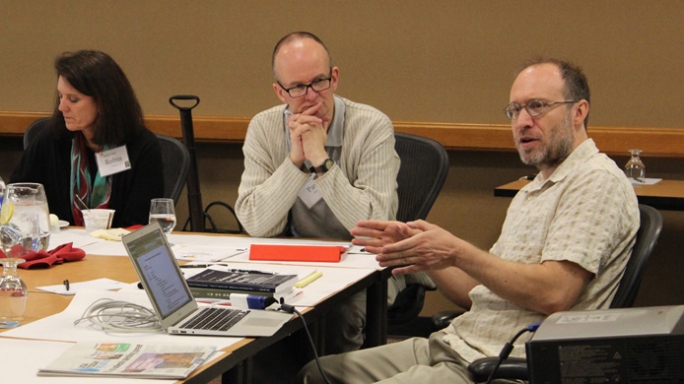You are here
Home › About › CNS-ASU News › Workshop brings together diverse "Communities of Integration"Workshop brings together diverse "Communities of Integration"
May 23, 2013

Bringing social scientists into natural science and engineering contexts is one of the central themes of CNS-ASU's research thrust on Integration (RTTA 4). At the Communities of Integration workshop, taking place this week in Tempe, AZ, Dr. Erik Fisher and the RTTA 4 team are seeking to establish a new field called ‘Socio-Technical Integration’ (STI).
There are many forms of STI that may be taking place globally, even if they don't identify themselves as such yet. This workshop, however, is bringing together five different communities that do identify as participating in this emerging field. Specifically, those communities are:
- SEESHOP (Studies of Experience & Expertise) brings together scholars from many disciplines interested in the empirical investigation of expertise and the impact of these studies on other academic fields.
- STIR (Socio-Technical Integration Research) embeds humanities scholars and social scientists in laboratories to probe the utility of collaborative inquiry in stimulating midstream modulation of material practices and technology development.
- The Toolbox Project examines the use of structured, philosophical dialogue as a means of facilitating collaborative communication in research across disciplinary lines.
- Trading Zones explores a new framework for fostering collaborations among existing disciplines and expertise communities.
- Conation is dedicated to cultivating an understanding of instinctive behavioral strengths, and the creation of teams that rely on a diversity of instincts being represented.
As introduced above, CNS-ASU's integration project, STIR, has been going on since 2006. STIR has pioneered the 12-week “laboratory engagement study” in which the results of ethnographic participant-observation are fed back into the field of study in real-time. This is done largely through a semi-structured “decision protocol” that asks fundamental, open-ended questions during routine specialist activities. The idea is not to influence the activity, but rather to observe the practices, and feed those observations back to the lab in order to promote reflection and consideration of their decision-making processes.
Due to the success of the STIR method, Dr. Fisher has been keen to bring together other integration approaches in order to share lessons and methods, as well as to start defining the field of STI together with those who share similar goals.
More information on the workshop is available on its homepage at http://stiworkshop.weebly.com/
This meeting was sponsored by the National Science Foundation (NSF), European Research Council (ERC), the Center for Nanotechnology in Society at Arizona State University (CNS-ASU), Cardiff University, and the Global Institute of Sustainability through the Walton Solutions Initiative.
Tags:
Want more like this? Get our newsletter.
Learn about upcoming events, publications and other CNS-ASU activities every month.
About
Tags
citizen science CNS engineering JRI nano and society nanodays nise net NSf outreach phoenix photovoltaic policy precipitation public engagement publishing research responsible innovation rtta 2 rtta 3 rtta 4 scenarios science science cafe science policy societal socio-technical integration solar solar power space STEM stir STS sustainability synthetic biology tempe festival of the arts the Design School trc 2 urban planning viri winter school



Add new comment